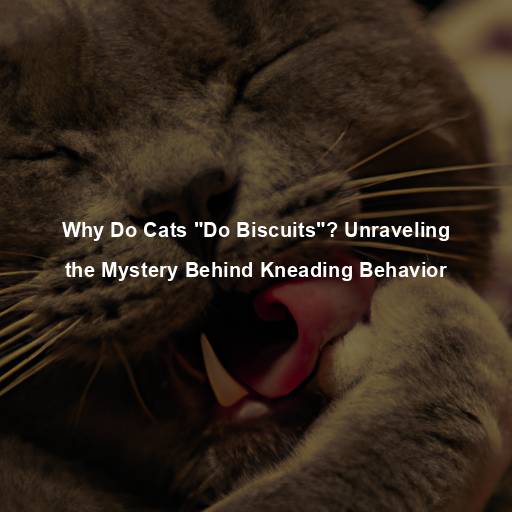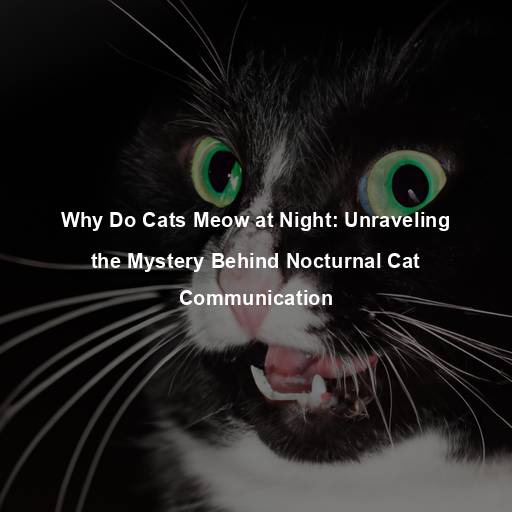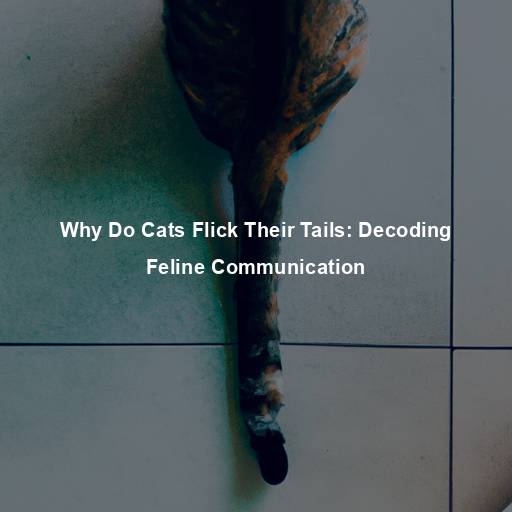Why Do Cats “Do Biscuits”? Unraveling the Mystery Behind Kneading Behavior
Last Updated on October 24, 2023 by Evan
Contents
- 1 Unveiling the Intricate World of Feline Behavior
- 1.1 The Kneading Phenomenon: A Curious Feline Ritual
- 1.2 An Ancient Instinct: Tracing Back to the Days of Kittendom
- 1.3 The Many Faces of Feline Kneading: A Multifaceted Behavior
- 1.4 The Science Behind the Kneading Behavior
- 1.5 Understanding and Encouraging Kneading Behavior
- 1.6 Comfort and Security: A Nurturing Ritual
- 1.7 Stretching and Flexing: Maintaining Suppleness
- 1.8 Territorial Marking: Claiming Ownership
- 1.9 Emotional Expression: Displaying Contentment
- 1.10 Seeking Attention: A Plea for Affection
- 2 Understanding Individual Variations
- 3 Addressing Common Misconceptions
- 4 The Enduring Enigma of Feline Kneading
- 5 Cultural Variations in Kneading Behavior
- 6 Addressing Concerns and Misconceptions
- 7 The Enigmatic Dance of Feline Kneading
- 8 FAQs – Why do cats do biscuits?
Unveiling the Intricate World of Feline Behavior
Cats have long fascinated us with their mysterious and enigmatic behaviors. From their graceful agility to their mesmerizing eyes, these independent creatures never cease to captivate our hearts. One peculiar behavior that has puzzled cat owners and enthusiasts alike is the rhythmic motion of kneading, commonly known as “doing biscuits”. In this intriguing essay, we delve into the depths of this feline behavior, exploring its origins, significance, and possible explanations.
The Kneading Phenomenon: A Curious Feline Ritual
Anyone who has experienced the enigmatic act of a cat’s affectionate kneading knows the profound mixture of bewilderment and pure bliss it induces. The enchanting ritual entails a mesmerizing dance as feline paws gracefully press and release against a cozy canvas, joined by a symphony of purrs and an ethereal look of contentment on their furry faces. However, this captivating behavior leaves us pondering an array of puzzling inquiries, adding to the allure of our enigmatic feline companions.
An Ancient Instinct: Tracing Back to the Days of Kittendom
The captivating phenomenon of kneading has long fascinated feline enthusiasts, leaving them to ponder its perplexing origins. Delving into the abyss of speculation, we find ourselves transported back to the formative stages of a cat’s existence. It is during these tender moments that an intricate dance unfolds between mother and kitten, as minuscule paws caress and massage the maternal bosom, evoking a primal response. A symbiotic bond is forged, as this instinctual act not only stimulates the flow of life-sustaining sustenance, but also encapsulates a delicate tapestry of survival and nurturing.
As cats grow older, the act of kneading persists, even in the absence of their mother. It is theorized that this behavior is deeply ingrained in their instincts, serving as a nostalgic reminder of their early bonding experiences and the comfort and security they associate with their mother’s presence.
The Many Faces of Feline Kneading: A Multifaceted Behavior
Kneading, that rhythmic and mesmerizing motion our feline friends engage in, may seem like a straightforward act, but it actually holds profound complexity and serves a multitude of purposes in their world. It’s a behavior that both perplexes and fascinates cat owners all around. So, why do cats partake in this delightful ritual of creating invisible bread? Let’s unravel the enigmatic layers and explore some of the most common explanations behind this mesmerizing cat phenomenon.
Marking Territory: Leaving Their Scent Behind
Cats possess scent glands in their paws, which they use to mark their territory. When a cat kneads, they release a unique scent from these glands onto the surface they are kneading. This behavior is believed to be a way for cats to claim ownership over their environment, leaving their mark and asserting their presence.
Contentment and Relaxation: The Ultimate Cat Massage
For many cats, kneading is a blissful and soothing experience. The repetitive motion of pushing and pulling against a soft surface can be incredibly relaxing for them. It is thought to release endorphins, which promote a sense of calm and contentment. This behavior often goes hand in hand with purring, further indicating a state of relaxation and happiness.
Nostalgia and Bonding: Revisiting Early Memories
Throughout a cat’s life, there is something inexplicably profound about the act of kneading. It harks back to their earliest memories, those tender moments spent nestling against their mother. As adults, when cats engage in this rhythmic motion, it’s as if they are transported back in time, finding solace and reassurance in the familiar. Kneading becomes a therapeutic ritual, easing anxieties and evoking a longing for the past.
Preparing a Comfy Spot: Creating a Bed of Their Own
In the wild, cats engage in kneading behavior to create a cozy and comfortable spot for themselves to rest. By kneading a soft surface, they can manipulate and shape it to their liking, ensuring a warm and snug resting place. This behavior harkens back to their ancestral instincts and their need to create a safe haven in their environment.
The Science Behind the Kneading Behavior
There is a fascinating and enduring mystery surrounding the behavior of cats known as “doing biscuits”. This puzzling phenomenon has captured the curiosity and speculation of many cat lovers and experts alike. Despite numerous theories floating around, it must be acknowledged that a concrete answer to this enigma remains elusive, largely due to the intricate and idiosyncratic nature of feline behavior. Nonetheless, several studies have shed some light on the potential underlying mechanisms, offering valuable glimpses into this intriguing mystery.
Recent studies have shed light on the fascinating connection between kneading and the release of oxytocin, a hormone fondly known as the “love hormone”. This hormone, known for its impact on social bonding and attachment, takes center stage when our feline friends indulge in kneading. The rhythmic motion of kneading awakens the oxytocin release, leading to a delightful sense of pleasure and connection for our beloved cats.
Understanding and Encouraging Kneading Behavior
Being a responsible pet owner means delving into our feline friends’ mysterious behaviors, like the enigmatic act of kneading. Unraveling the secrets behind this captivating ritual is crucial to nurturing a harmonious bond with our beloved cats. Therefore, let’s dive into a world of intrigue and discover some enlightening tips to create a conducive space for their rhythmic paw movements!
Provide Suitable Surfaces
If you’re looking to indulge your feline friend’s kneading tendencies, why not treat them to a luxurious assortment of cozy surfaces? Consider laying out a velvety blanket, a fluffy pillow, or even a plush bed, offering them a comforting experience reminiscent of their mother’s nurturing presence. These soft materials mimic the texture of their mother’s fur, leaving your cat in a state of pure feline bliss.
Create a Relaxing Atmosphere
Creating a serene and tranquil haven for your feline companion is of utmost importance. By minimizing disruptive sounds and offering cozy hiding spots or elevated perches, you can grant your beloved cat a sanctuary where they can retreat to in moments of seeking solitude and a sense of security. It is pivotal to prioritize their peace of mind, ensuring their environment exudes a calming aura that fosters their well-being.
Never Discourage or Punish
It’s fascinating how cats have this innate desire to knead, almost as if it’s hardwired into their very being. Rather than discouraging or reprimanding them for this instinctual behavior, it’s important to guide their kneading towards more suitable surfaces when it starts to inconvenience or disturb you. Redirecting their actions with gentle guidance can help create a harmonious environment for both you and your feline companion.
Bonding Through Interaction
Building a harmonious relationship with your feline friend involves immersing yourself in a symphony of tender interactions. Delighting in the art of gentle petting and soothing strokes, you become the maestro of their contentment, nurturing their sense of comfort and security. These precious moments of connection not only deepen the bond between you and your whiskered confidant, but also create a tapestry of affection that resonates with enigmatic captivation.
Comfort and Security: A Nurturing Ritual
There’s something oddly fascinating about witnessing our feline friends engage in that rhythmic motion we call kneading. It’s like a captivating dance, a mesmerizing blend of instinct and nostalgia. Originally rooted in the wild, where tiny kittens would knead their mother’s belly to ensure a good milk supply, this endearing behavior has transcended into adulthood, becoming a symbol of comfort and tranquility for our furry companions. It’s as if they’re yearning to recreate the warm embrace of their early days, seeking solace in the rhythmic movement that once defined their existence.
Stretching and Flexing: Maintaining Suppleness
Ever wondered why cats engage in that peculiar activity of kneading? Turns out, it’s not just a quirk but a clever way for our feline friends to exercise and flex their paw muscles. Just like humans rely on stretching to keep our muscles limber, cats use this repetitive motion to maintain the suppleness and prevent stiffness in their precious paws. So, the next time you catch your furry companion kneading away, appreciate their feline fitness routine!
Territorial Marking: Claiming Ownership
Did you know that when cats knead, they’re actually sending out a fragrant message? It turns out that these adorable creatures have scent glands in their paws, and by kneading, they’re leaving their own unique scent behind. This fascinating feline behavior is a way for them to mark their territory and alert other cats of their presence, especially in households with multiple cats or those that roam the great outdoors. So the next time your fluffy companion starts kneading away, know that they’re not only trying to cozy up to you, but also making their presence known to the feline world around them.
Emotional Expression: Displaying Contentment
There’s a captivating sight that often accompanies our feline friends’ moments of sheer bliss: the rhythmic motion of their paws as they gracefully knead the surface beneath them. This endearing behavior, often accompanied by a melodic purr, speaks volumes about the emotional state of our whiskered companions. As they engage in this soothing ritual, it becomes clear that cats have found their own unique way of expressing contentment and relaxation, a visual symphony of happiness and fulfillment in their surroundings.
Seeking Attention: A Plea for Affection
In some cases, cats may knead as a way to seek attention from their human companions. They have learned that kneading often elicits a positive response from their owners, such as petting or cuddling. Consequently, they may use this behavior as a means to initiate interaction and receive affection.
Understanding Individual Variations
While kneading is a common behavior among cats, it is important to recognize that each cat may exhibit unique variations in their kneading style and preferences. Some cats may prefer certain textures or surfaces, while others may engage in more vigorous kneading motions. It is essential to observe and understand your cat’s individual preferences to provide them with the most comfortable and enjoyable experience.
Addressing Common Misconceptions
When it comes to our feline friends, there can be a fair share of misunderstandings about their behavior. And one area that often raises eyebrows is their propensity for kneading. However, let’s unravel the web of misconceptions surrounding this intriguing behavior and shed some light on what’s really going on when cats engage in this rhythmic motion.
Kneading is Not Aggressive Behavior
Kneading is a natural behavior and should not be mistaken for aggression. Although some cats may knead with their claws slightly extended, it is typically a gentle and non-threatening action. If your cat’s kneading becomes too intense or uncomfortable, you can redirect their behavior to a suitable surface or provide them with a soft blanket or cushion to knead.
Kneading is Not Always a Sign of Contentment
The act of kneading may seem like a happy expression for cats, but it’s not the only signal of their emotional state. Cats can also knead when they’re dealing with anxiety, stress, or simply searching for solace. To truly understand your feline friend’s emotional well-being, it’s important to take into account their other behaviors and body language as well.
Kneading is Not Exclusive to Female Cats
There’s a cat-mystery afoot! Despite stereotypes, it turns out that both feline genders are guilty of the adorable act of kneading. While many assume it to be a female-driven instinct tied to motherhood, male cats have also been seen indulging in this cozy behavior, proving that comfort and relaxation are not bound by societal expectations. Prepare to be pawsitively perplexed by the burst of cuteness that awaits when watching cats kneading like professionals!
The Enduring Enigma of Feline Kneading
Unlocking the enigma of feline kneading behavior remains a perplexing puzzle, despite our extensive knowledge in the realm of feline cognition. The intricacies of this seemingly simple act continue to evade our understanding, with each cat unveiling their unique interpretation of this ritualistic behavior. As we marvel at the mesmerizing complexity inherent in our feline companions, let us bask in the sheer delight and tender moments when they grace us with their kneading rituals, forging an unbreakable bond between human and feline.
For more fascinating insights into the world of pets, stay tuned to PetsRoof.com: Your Go-To Source for All Things Pets!## Unraveling the Origins of Kneading Behavior
As feline enthusiasts, we have embarked on a captivating journey to decipher the fascinating phenomenon of cats kneading. Despite our relentless efforts, the elusive origins of this behavior continues to baffle us. Join us as we delve into the enigmatic depths of the evolutionary theories that may shed light on this mesmerizing cat behavior.
An Evolutionary Remnant: Tracing Back to Wild Ancestors
There’s an intriguing notion swirling around that kneading behavior in cats might be a lingering trait from their wild feline predecessors. Out in the untamed wilderness, these majestic creatures would gracefully engage in comparable motions, delicately manipulating their paws to tenderize and flatten foliage before seeking solace or bringing new life into the world. Over time, this primal behavior could have been engraved within their instincts, passed down like a captivating enigma through generations of mesmerizing feline heritage.
A Sign of Contentment: An Evolutionary Advantage
Throughout their evolution, cats have exhibited a perplexing behavior known as kneading. This curious act, which involves rhythmic pressing of their paws into soft surfaces, baffles us to this day. But what if kneading served a deeper purpose? Could it be a form of communication, a signal of contentment and relaxation to their feline peers?
Reinforcing Social Bonds: A Survival Strategy
Kneading behavior may have also played a role in strengthening social bonds among cats. In wild cat colonies, kneading could have been a way to establish trust and cooperation among individuals, contributing to the overall survival and success of the group. By engaging in kneading, cats may foster a sense of unity and cooperation within their social structures.
Cultural Variations in Kneading Behavior
Discover the fascinating world of feline kneading behavior and delve into the diverse tapestry of cultural customs that surround this quirky phenomenon. Embark on a journey across continents as we unravel the enigmatic nuances of kneading peculiar to various regions. Prepare to be captivated by the intricate tapestry of cultural diversity that shapes this endearing feline behavior. Embrace the burst of curiosity as we untangle the perplexing threads that bind cats and their kneading rituals around the globe.
The “Making Biscuits” Phenomenon
For feline aficionados worldwide, there exists a peculiar yet enchanting phenomenon known as “making biscuits”. This peculiar moniker, borrowed from the culinary realm, captures the rhythmic symphony of a cat’s paws as they gracefully dance upon a plush surface. As the enigmatic cat world continues to unfold its secrets, this endearing phrase has effortlessly woven its way into the hearts of cat owners, kindling a captivating fascination with their kneading rituals. So, the next time your furry companion begins their intricate paw choreography, remember, it’s not just kneading—it’s an adorable homage to the art of biscuit-making.
Kneading as a Sign of Affection in Japan
In Japan, kneading behavior is commonly associated with cats showing affection towards their human companions. This cultural interpretation highlights the bond between cats and their owners, with kneading seen as a loving gesture. Japanese cat owners often embrace kneading as a heartwarming expression of their feline companion’s affection.
Symbolic Meanings in Ancient Cultures
Across different eras, felines have been enigmatically intertwined with the tapestry of human existence, holding a myriad of symbolic meanings. Take ancient Egypt, a civilization bedecked with mystique and awe; they worshipped these enigmatic creatures as sacred beings, imbued with the forces of fertility and the essence of motherhood. It’s fascinating to ponder how the intriguing act of kneading, so innocently exhibited by our modern-day house cats, might have been perceived as an eloquent portrayal of the nurturing and protective attributes attributed to these majestic beings in the tapestry of ancient cultures.
Addressing Concerns and Misconceptions
When it comes to the topic of kneading, there are often misconceptions and concerns that can leave us feeling perplexed. However, it is important to unravel these uncertainties and explore potential solutions. So, let’s dive in and clear the air on some common concerns surrounding this behavior.
Scratching During Kneading
Some cats may exhibit scratching behavior while kneading, which can be concerning for owners. To address this, providing appropriate scratching posts or surfaces can redirect their scratching instincts and protect your furniture. Regular nail trimming can also help minimize any potential damage caused by scratching.
Kneading on Sensitive Areas
Cat owners often find it quite enjoyable when their furry companions engage in the age-old practice of kneading. However, it can become a perplexing situation when our feline friends decide to knead on tender or achy parts of our bodies. Should this become discomforting, it is recommended to gently guide their behavior towards a more suitable surface or employ a tender barrier to shield those sensitive areas.
Excessive Kneading
Sometimes, our feline friends exhibit unusual behavior that puzzles us. Take, for instance, the enigmatic phenomenon of excessive kneading. This perplexing act could be a cryptic message from our cats, hinting at hidden discomfort or anxiety lurking beneath the surface. If you happen to witness a sudden surge in kneading frequency or intensity, it might be wise to seek the guidance of a veterinary expert.
The Enigmatic Dance of Feline Kneading
As we conclude our exploration of kneading behavior in cats, we are reminded of the enduring mysteries that surround our feline friends. While we may never fully unravel the secrets behind why cats “do biscuits,” we can appreciate the beauty and complexity of their behaviors. Kneading serves as a gentle reminder of the deep bonds we share with these remarkable creatures.
Stay tuned for more captivating insights into the world of pets, only on PetsRoof.com: Your Go-To Source for All Things Pets!
FAQs – Why do cats do biscuits?
What does it mean when a cat does biscuits?
Have you ever wondered why your feline friend suddenly transforms into a talented baker, kneading imaginary dough with their adorable paws? Well, prepare to be mystified, because this behavior, aptly known as “doing biscuits,” is as perplexing as it is endearing. Whether they’re claiming your lap as their own personal spa or simply expressing their sheer bliss, cats have mastered the art of kneading, turning any soft surface into a canvas for their paw-powered masterpiece. So, the next time your furry companion starts their rhythmic motion, remember that behind those dough-like paws lies a burst of inexplicable happiness and an ancient form of feline communication.
Why do cats knead?
Cats knead for various reasons, and it can be a combination of instinctual, physical, and emotional motivations. Kneading is believed to originate from a kitten’s behavior while nursing, as they push against their mother’s mammary glands to stimulate milk flow. As they grow older, the kneading behavior may continue as a way to maintain that comforting feeling associated with nursing.
Is kneading a sign that my cat is happy?
Cat owners often wonder about the meaning behind their feline friends’ adorable habit of kneading. The truth is, kneading is usually a positive indication that your cat is feeling relaxed and content. This rhythmic motion is commonly seen when a cat is purring, enjoying your presence, or simply in a state of bliss. The kneading action actually triggers the release of endorphins, giving them a gentle sense of pleasure and comfort. However, it’s worth mentioning that cats are multifaceted creatures, and their behavior can sometimes puzzle us. Some cats may engage in kneading when they’re feeling anxious or in need of extra attention. As with all things cat-related, it ultimately boils down to each individual kitty’s unique personality and preferences.
Can kneading be a sign of health issues?
While kneading is generally a harmless behavior, excessive or aggressive kneading can sometimes indicate underlying health issues. If you notice your cat excessively kneading to the point of irritation or causing injury to themselves or objects, it is recommended to consult a veterinarian. Occasionally, medical conditions such as pain, skin allergies, or discomfort in the paws can manifest through heightened kneading behavior.
How can I encourage or discourage my cat from kneading?
Want to unlock the enigma behind your cat’s kneading behavior? Look no further! Transform the perplexing act into a burst of comfort by offering them a snuggly blanket or plush bed, igniting a symphony of blissful purrs. Shower them with gentle strokes and praise, turning their kneading into a sensational experience they won’t resist. However, if things get a tad too intense or inconvenient, divert their attention towards the captivating world of toys, enticing scratching posts, or majestic climbing structures, granting them an outlet for their boundless energy.
Is it normal if my cat does not knead?
Yes, it is entirely normal for some cats not to knead at all. Not all cats exhibit this behavior, and it varies from cat to cat. If your cat does not knead, it does not necessarily mean anything is wrong or that they are unhappy. Cats have unique personalities and preferences, so the absence of kneading should not be a cause for concern as long as your cat is displaying other healthy behaviors.







